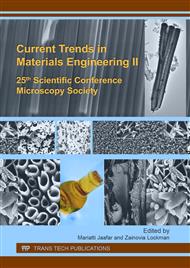p.124
p.128
p.132
p.136
p.140
p.144
p.148
p.152
p.156
Surface Morphology and Hydrophilicity Evaluation of PLA Microspheres Treated with Boronhydride (NaBH4) at Different Concentrations
Abstract:
In drug delivery system, a controlled drug delivery carrier is favorable to ensure the delivery of drug at suitable and required rate and dosage to the targeted area. Microsphere is one of the approaches used to deliver drug in a controlled manner. A biodegradable poly (lactic) acid (PLA) has been used widely for drug delivery due to the fact that the polymer was non-toxic with a biodegradable property. Therefore, PLA microspheres were utilized in this research works. On the other hand, the major drawback of PLA is its extremely hydrophobic properties which limit its application in drug delivery system. In order to overcome this problem, surface modification via alkaline hydrolysis has been made on PLA. This research investigated the effect of surface modification with sodium boronhydride (NaBH4) at different concentrations and temperatures on the properties of PLA microspheres. The enhancement of hydrophilicity of PLA microspheres has been evaluated using FTIR and SEM. From these evaluations, it was found that the hydrophilicity of PLA microspheres had increased as the concentration of NaBH4 and temperature increased.
Info:
Periodical:
Pages:
140-143
Citation:
Online since:
September 2017
Authors:
Price:
Сopyright:
© 2017 Trans Tech Publications Ltd. All Rights Reserved
Share:
Citation:


